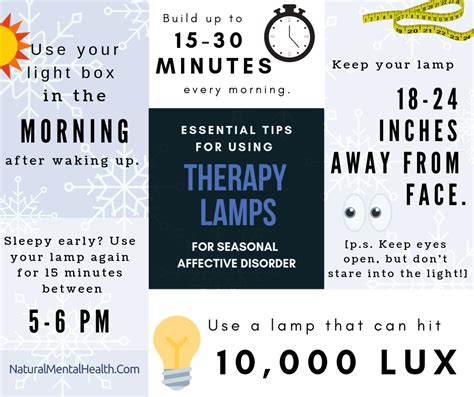Seasonal Affective Disorder (SAD) is a type of depression that affects millions of people worldwide, particularly during the winter months when the days are shorter and darker. The lack of sunlight can disrupt the body’s internal clock and lead to feelings of sadness, lethargy, and social withdrawal. One of the most effective treatments for SAD is light therapy, which involves exposure to a specialized light that mimics natural outdoor light.
Light therapy is based on the principle that the body has an internal clock that regulates our sleep-wake cycle, hormone secretion, and other physiological processes. This internal clock is controlled by a small group of cells in the brain called the suprachiasmatic nucleus (SCN), which responds to light and dark signals from the environment to synchronize our bodily functions with the 24-hour day-night cycle. In people with SAD, the SCN can become desynchronized due to the reduced sunlight during the winter months, leading to a range of symptoms including depression, fatigue, and social withdrawal.
The use of light therapy for SAD was first introduced in the 1980s, and since then, it has become a widely accepted treatment for the condition. The therapy involves exposure to a bright light box or a portable light device that emits a specific intensity and spectrum of light, typically in the range of 10,000 lux. This intensity is much brighter than a normal household light, which is usually around 400-800 lux. The light is designed to stimulate the SCN and help regulate the body’s internal clock, which can help to improve mood, energy levels, and overall sense of well-being.
There are several types of light therapy devices available, including light boxes, portable lights, and dawn simulators. Light boxes are the most common type of device and typically consist of a flat screen that emits a bright, full-spectrum light. Portable lights are smaller and more convenient, making them ideal for people who need to use light therapy on the go. Dawn simulators are devices that gradually increase the light in the room over a set period, simulating a sunrise and helping to wake the user up in the morning.
The benefits of light therapy for SAD are numerous. Studies have shown that light therapy can be as effective as medication in improving mood and reducing symptoms of depression. It is also a relatively safe and side-effect-free treatment, making it an attractive option for people who prefer not to take medication or who have experienced side effects from other treatments. Additionally, light therapy can be used in conjunction with other treatments, such as medication and therapy, to provide a comprehensive approach to managing SAD.
In addition to its use in treating SAD, light therapy has also been shown to be effective in managing other conditions, including non-seasonal depression, bipolar disorder, and sleep disorders. It has also been used to help regulate the body’s internal clock in people who work non-traditional hours, such as shift workers, and to improve alertness and productivity in people who experience jet lag.
Despite its many benefits, light therapy is not without its limitations. One of the main limitations is that it requires consistent and regular use to be effective. This can be a challenge for people who have busy schedules or who find it difficult to stick to a routine. Additionally, light therapy may not be suitable for people who have certain medical conditions, such as eye problems or epilepsy, and it is not recommended for people who take certain medications, such as those that increase sensitivity to light.
In conclusion, light therapy is a highly effective treatment for SAD and other conditions related to the body’s internal clock. By providing a safe and natural way to regulate the body’s internal clock, light therapy can help to improve mood, energy levels, and overall sense of well-being. While it may have its limitations, the benefits of light therapy make it a valuable treatment option for people who experience SAD and other related conditions.
What is the best time of day to use light therapy for SAD?
+The best time to use light therapy for SAD is in the morning, shortly after waking up. This helps to regulate the body's internal clock and can help to improve mood and energy levels throughout the day. It is generally recommended to use light therapy for 20-30 minutes in the morning, although the specific duration and timing may vary depending on the individual's needs and circumstances.
Can I use a tanning bed or a lamp to get light therapy?
+No, it is not recommended to use a tanning bed or a lamp to get light therapy. Tanning beds and lamps emit ultraviolet (UV) radiation, which can be harmful to the skin and eyes. Light therapy devices, on the other hand, emit a specific spectrum and intensity of light that is designed to be safe and effective for treating SAD and other conditions. Using a tanning bed or a lamp for light therapy can increase the risk of eye damage, skin cancer, and other health problems.
How long does it take to see results from light therapy?
+The amount of time it takes to see results from light therapy can vary depending on the individual and the specific condition being treated. Some people may notice an improvement in their mood and energy levels within a few days of starting light therapy, while others may take several weeks to experience the full benefits. It is generally recommended to use light therapy consistently for at least 2-4 weeks to determine its effectiveness.
In terms of the technical aspects of light therapy, it is worth noting that the intensity and spectrum of the light can vary depending on the device and the individual’s needs. The most common type of light therapy device emits a full-spectrum light, which is designed to mimic natural outdoor light. This type of light is typically in the range of 10,000 lux, which is much brighter than a normal household light. The device is usually placed at a distance of 16-24 inches from the user, and the light is directed towards the face and eyes.
The use of light therapy devices has been extensively studied in clinical trials, and the results have consistently shown that it is a safe and effective treatment for SAD and other conditions. One of the most significant benefits of light therapy is its ability to regulate the body’s internal clock, which can help to improve mood, energy levels, and overall sense of well-being. Additionally, light therapy has been shown to be effective in reducing symptoms of depression, anxiety, and other mental health conditions.
Overall, light therapy is a highly effective treatment for SAD and other conditions related to the body’s internal clock. By providing a safe and natural way to regulate the body’s internal clock, light therapy can help to improve mood, energy levels, and overall sense of well-being. While it may have its limitations, the benefits of light therapy make it a valuable treatment option for people who experience SAD and other related conditions.
Light therapy is a highly effective treatment for SAD and other conditions related to the body's internal clock. It works by providing a safe and natural way to regulate the body's internal clock, which can help to improve mood, energy levels, and overall sense of well-being.
Getting Started with Light Therapy
- Consult with a healthcare professional to determine if light therapy is right for you.
- Choose a light therapy device that meets your needs and budget.
- Place the device at a distance of 16-24 inches from your face and eyes.
- Use the device consistently for 20-30 minutes in the morning.
- Monitor your progress and adjust the device as needed.
Pros and Cons of Light Therapy
- Pros:
- Effective in treating SAD and other conditions related to the body’s internal clock.
- Safe and natural way to regulate the body’s internal clock.
- Can be used in conjunction with other treatments.
- Cons:
- Requires consistent and regular use to be effective.
- May not be suitable for people with certain medical conditions or who take certain medications.
- Can be expensive, especially for high-quality devices.



